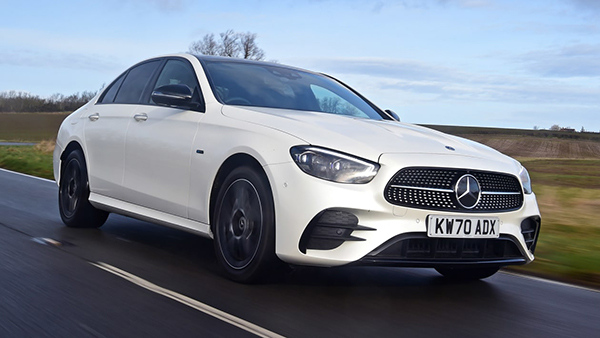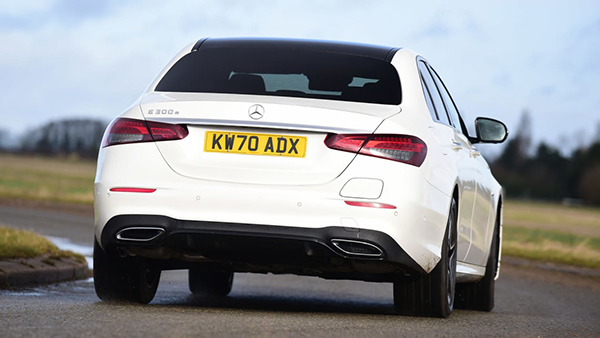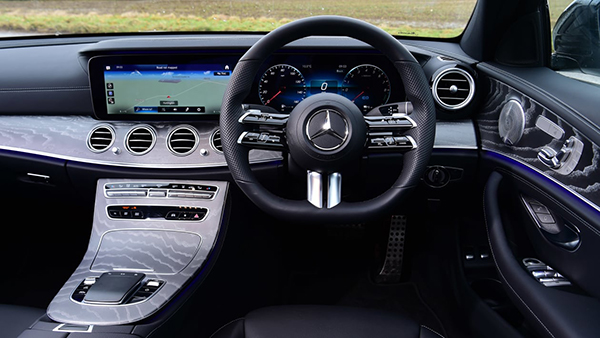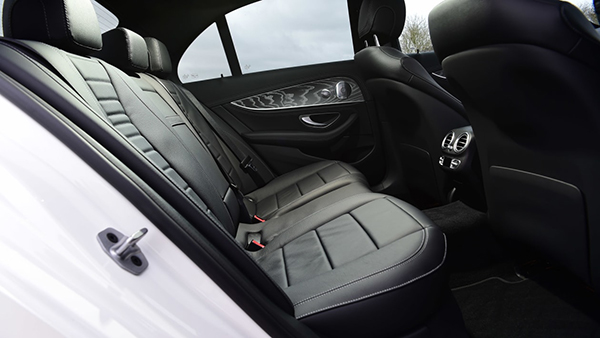Mercedes-Benz E-Class is about as traditional as you can get in the executive saloon market – it feels a lot like a smaller S-Class, which is a good thing, as it sets high standards in the class for comfort and has an impressively sumptuous cabin.
While it’s more expensive than its rivals, even the entry-level Sport versions are well equipped and, overall, it’s an efficient and stylish package that’s well worth considering if you’re in the market for a new executive saloon.

About the Mercedes E-Class
There was a time when Mercedes’ line-up was based exclusively on this size of saloon, but today there are so many different models in the range that the E-Class faces the risk of being lost in the line-up. Fortunately, Merc knows that the E-Class is still one of the most important models in its range, so it gets a host of hi-tech gadgets, advanced engines and a plush fit and finish to maintain its appeal.
Refinement is also top notch, while the S-Class-inspired technology makes it safer and easier to live with. It’s not quite as fun to drive as a Jaguar XF or BMW 5 Series, but it’s close enough in a class where cruising ability and composure count. The entry-level diesel is now faster and more efficient than ever, too, which will be important for business users, while there’s some scorching AMG-badged performance models for those who need more pace.
The current E-Class arrived in 2016, but while the W213 model is the fifth-generation to wear the E-Class badge, its saloon roots can be traced all the way back through to the Ponton Mercedes saloons of the 1950s. There are some illustrious models in the Mercedes saloon back catalogue, including the W114 and W124, but with every model, Mercedes has improved its executive saloon to keep it competitive in the sector.
The E-Class name first arrived in 1993, when the facelifted W124 model hit showrooms with the newly added E badge on its name, and almost 30 years later the E-Class is still one of the leading lights in the executive saloon class. Its main rivals are its German counterparts in the shape of the Audi A6 and BMW 5 Series, while the Jaguar XF is a strong contender, too. In addition, high-end versions can rival the Tesla Model S and Porsche Panamera, while cars like the Lexus ES and Volvo S90 offer something different in the class. At the very top of the tree, the AMG E 63 S is a super saloon that delivers supercar pace in a luxury four-door package.
Like the last model, the current E-Class is offered in four body styles: four-door saloon, estate (including the four-wheel-drive All-Terrain Edition), coupe and convertible. All versions borrow technology from the S-Class limousine, while the styling gains some influence from that model, too. The saloon really does look like a shrunken S-Class, and it could even be difficult to distinguish it from the C-Class from a distance.
Mercedes facelifted the E-Class in 2020, with exterior styling tweaks including reshaped lights, a new radiator grille and a reprofiled bumper. At the rear of the saloon model, the previous rounded taillights have been switched for wider units. The E-Class also comes with the manufacturer’s latest MBUX infotainment system as standard, with two 12.3-inch screens.
The entry Sport trim is followed by four variations of the AMG specification: AMG Line Edition, AMG Line, AMG Line Premium and AMG Line Night Edition Premium Plus. Even in standard guise the Sport version is pretty well equipped, while AMG Line adds a sportier look with bigger wheels, although as well as the two Premium packages, there are a range of options that can be added, too.
There’s a decent range of engines in the E-Class, with diesel, petrol and hybrid powertrains on offer. The E 220 d and E 300 d four-cylinder variants, along with the E 400 d straight-six unit make up the diesel range, while a single four-cylinder 2.0-litre, fitted to the E 200, covers the lower end of the petrol line-up.
Two hybrids are available with a 2.0-litre four-cylinder engine fueled by either petrol or diesel and mated to an electric motor. The E 300 e is the petrol version and the E 300 de is the diesel. Both offer an all-electric range of around 33-35 miles.
At the top of the standard petrol range is the E 450 4MATIC, followed by the beefy AMG E 53 and AMG E 63 S models. The AMG cars have straight-six or V8 twin-turbo engines respectively, with 4MATIC four-wheel-drive standard on both. All E-Class versions feature a nine-speed auto gearbox.
Prices start from almost £40,000 for the E 200 model, while all other models sit above the £40,000 road tax threshold. The most expensive E 63 S saloon is over £100,000.
It’s not the sharpest large saloon on sale, but the E-Class delivers when it comes to comfort and refinement. Steel springs with adaptive dampers are standard in the UK, while fully adaptive air-suspension is an option.
The standard coil springs and adaptive damper suspension set-up does a better job of soaking up bumps than the firmer Jaguar XF, but trails the BMW 5 Series for ultimate comfort. While it deals with big bumps well, broken tarmac and potholes send the occasional shake and shudder through the floor of the cabin. Cars with optional air-suspension ride serenely, offering lots of composure, plenty of comfort and good body control. While the car floats along nicely on faster, smoother roads, go for an AMG Line model, and the larger wheels mean the ride will feel a little unsettled on more jagged surfaces.
There are different driving modes to sharpen up the steering, throttle response and damping, but it’s best to leave the E-Class in Comfort and make the most of its cosseting, refined ride. Hit a corner quickly, and you’ll find body control soft in Comfort mode. Sport or Sport+ settings reduce roll, but also add an artificial weight to the lifeless steering. It’s not as agile as the sportier XF, but you can’t fault its grip and composure.
The impressive ride stems from the E-Class’ weight loss plan, having shed “around 100kg” over its predecessor depending on spec, according to Mercedes. Aluminium body panels have helped here, meaning the E-Class delivers a fluid ride even over poor road surfaces.
Combined with the impressive levels of refinement from the engines and the standard nine-speed automatic gearbox, which slurs changes nicely and responds sharply enough to pulls on the steering wheel mounted paddles, it’s easy to make relaxed progress.
Whereas the BMW 5 Series and Jaguar XF offer more for keen drivers, the E-Class puts the focus more on comfort and quality, delivering a relaxed drive at the expense of some handling performance that, for most people day-to-day, will be a welcome benefit.
You can still drive it hard and lean on the decent amount of grip available, but it doesn’t feel quite as natural as in some larger saloons. There’s always a reassuring, planted feel on the road though, while Mercedes’ clever safety systems – including the E-Class’ standard autonomous braking – offer peace of mind.

Engines, 0-60 acceleration and top speed
Mercedes’ 2.0-litre four-cylinder turbodiesel opens the E-Class range in the E 220 d. With 191bhp and 400Nm of torque on offer in the latter, this is now faster than the old E 250 d, but importantly the new 2.0-litre unit is much quieter than the clattery old 2.1-litre diesel.
The 0-62mph sprint takes 7.3 seconds, while top speed stands at 149mph, but it’s the smooth, subdued pulling performance that impresses most. Refinement is much improved, and the new four-cylinder diesel is easily a match for the 2.0-litre Ingenium unit in the Jaguar XF when it comes to a subdued idle and quiet cruising on the motorway. The nine-speed auto gearbox makes for low cruising revs of just 1,300rpm at 70mph, and the car’s slippery shape also means there’s virtually no wind noise.
If you want extra performance, the E 400 d 4MATIC certainly offers that. With its 3.0-litre turbo diesel straight-six there’s a mammoth 700Nm on tap. This, combined with 335bhp, gives a seriously quick 4.9 second 0-62mph sprint. However, it’s how the E 400 d pulls from low revs with plenty of potency that demands your attention.
Squeeze the throttle and the engine pulls hard from as low as 1,200rpm. Also, it will happily plod along at 30mph in sixth gear and accelerate all the way up to motorway speeds with minimal fuss. There’s no real need to wring the engine out past 3,000rpm because of the effortless power delivery. Add in the supple ride quality and the E 400 d is simply one of the most relaxing and refined cars in which to cover long distances.
But, if you’d rather not have an oil-burner, then the capable E 450 4MATIC could be the answer – powered by a 3.0-litre six-cylinder petrol engine, it produces 362bhp and 500Nm of torque and reaches 0-62mph in 5.1 seconds.
The 429bhp AMG E 53 acts as a go-between for the standard E-Class models and the fire-breathing AMG E 63 S. It combines straight-six power with 48v mild-hybrid technology to help optimise performance. There’s plenty of grunt to be exploited in the mid-range, thanks to the 520Nm torque output. Acceleration is decent too, taking only 4.5 seconds to get from 0-62mph.
The top-of-the-line engine is the E 63 S, with a massive 4.0-litre V8 giving 604bhp. Performance is a step above the E 53, tackling the 0-62mph sprint in 3.4 seconds and pressing on, if you go for the optional £765 AMG Driver’s Package, to a top speed of 186mph.
It’ll be the E 220 d that makes up the majority of sales in the UK. However, Mercedes’ frugal E 300 e and E 300 de plug-in hybrids aim to be successful in the business market.
Combining a turbocharged 2.0-litre four-cylinder petrol or diesel engine with an electric motor, the cars offer brisk performance, with both producing over 300bhp and 700Nm of torque. The two hybrids will cover 0-62mph in less than six seconds and press on to top speeds in excess of 155mph.
On the road, the E 300 e shows how far electrification has come. If you’re careful, (and if you follow the car’s suggested economical route) you should be able to squeeze more than 30 miles of pure-electric driving, which is enough for most morning commutes. The car feels a little less keen to change direction thanks to the extra weight of its batteries, but the plug-in hybrid is still good to drive and very comfortable.
Not only is the 2.0-litre diesel in the E 220 d faster and more refined, it’s also more efficient. Combined fuel economy is 53.2mpg under WLTP testing. Also, on the Sport model’s standard 17-inch wheels, CO2 emissions are now 139g/km.
Opt for the E 400 d and the vital figures aren’t quite as impressive, with a claimed maximum of 42.2mpg and CO2 emissions of 176g/km, but this is still fairly competitive efficiency compared to its rivals and good considering the level of performance on offer. However, you’ll be spending even more time at the filling station if you choose the petrol E 450 4MATIC – its 3.0-litre six-cylinder unit returns just 31.4mpg on the combined cycle.
The E 53 AMG manages 30.4mpg and 208g/km of CO2, which again is impressive for such a powerful motor – but in the real world those figures will be some way off, especially if you’re driving it as intended.
The E 300 e and E 300 de are the most efficient of the bunch, emitting between 33 and 36g/km of CO2, and remember that if you can make use of the 30-mile plus electric range then you won’t use a single drop of fuel.
All cars get stop-start to help reduce tailpipe emissions, while other features such as clever aerodynamics further improve efficiency. The new E-Class has a drag coefficient of 0.23 Cd, which is actually 0.01 lower than the latest Toyota Prius, an already very aerodynamically advanced vehicle, showing how well the Merc slips through the air, using less fuel in the process.
Private buyers will have to do their sums carefully to avoid paying too much road tax, with only the entry-level E 200 model coming in under the £40,000 road tax threshold.
Insurance groups
The entry-level E 200 Sport is rated at group 34, while AMG Line trim takes this up to group 36 for both the petrol and E 220 d diesel versions. The top-of-the-range E 63 S will predictably incur expensive premiums being in group 49. The popular
Insurance groups for the E 300 e and E 300 de are also higher because of the expensive hybrid tech and the potential for increased repair costs following an accident. In AMG Line trim, they sit in groups 44 and 46 respectively.
Depreciation
With predicted residual values hovering around 49% according to our experts, the new E-Class is on a par with rivals when it comes to depreciation. The plug-in hybrid models fare a little better than the rest of the range, holding onto 50-54% of their original list price over 3-years and 36,000 miles.
From the outside, the Mercedes E-Class takes styling inspiration from the larger S-Class, and it ditches its predecessor’s boxy design in favour of the limousine’s more svelte curves. While the design might not be to everyone’s tastes, the higher-spec AMG Line model has lots of kerb appeal. A facelift in 2020 brought some changes to the exterior, with redesigned lights, a new grille and reprofiled bumper.
Step aboard, and the interior also takes its design cues from the S-Class, with a minimalist approach to the dashboard layout. The fascia flows across the cabin, featuring four circular air vents in the centre, while the twin 12.3-inch screens display crisp, sharp graphics.
There is a striking new steering wheel design, housing touch-sensitive controls for functions such as volume, cruise control and the digital driver information. It takes a little getting used to, but the systems it controls are still typically up to the mark.
You can’t fault the technology on offer, however. Self-parking is standard on the Sport trim, as is a reversing camera, sat-nav, LED headlights, Mercedes’ Active Brake Assist, climate and cruise control, keyless go, DAB and heated seats.
Upgrading to the AMG Line specification brings bigger 18-inch alloys, privacy glass and three-way climate control, while the Premium versions add an inch to the wheel size with the Plus variant including a panoramic sunroof.
Allied to the advanced tech inside, the E-Class’ interior puts the A6 and 5 Series in the shade, and beats the Jaguar XF, too.

Sat-nav, stereo and infotainment
Mercedes’ MBUX infotainment is up there with the best systems in the class, featuring sharp graphics, quick responses to any inputs and the latest tech. The logical menu layout means it’s easy to navigate your way through the different menus, too.
The E-Class is a full five-seater, and although the transmission tunnel restricts room in the middle slightly, the E-Class still offers enough space for five fully grown adults on shorter journeys. That’s thanks to the comfortable seats and, for the driver and front passenger, plenty of adjustment.
A softer chassis setup compared to rivals means the E-Class focuses on comfort more than sportiness, floating nicely over rippled roads. However, the big body and chunky C-pillars mean rear visibility over the shoulder isn’t the best – but with features like blind spot assist available, there’s enough safety tech to help out here.
That enlarged body means there’s lots of room inside, so the E-Class offers good storage. A deep central cubby between the front seats gives lots of space to stow items, while a large trinket tray in front of the multimedia controller gives a place to put mobile phones – in fact, this is where the wireless charging option is located if specified.
Decent sized door bins that run the length of the doors and a large glovebox give some extra storage, too.
Size
As mentioned, the E-Class has grown compared to its predecessor, so this new model is now 43mm longer than before at 4.9m.
Despite the space inside this fifth-generation E-Class is actually now narrower and shorter too, showing how Mercedes has cleverly optimised the layout inside to maximise passenger room and comfort.
It’s a similar length to all of its main rivals, with the Jaguar XF, BMW 5 Series and Audi A6 also all hovering around the 4.9m mark, but with a reversing camera as standard and an optional 360-degree monitor available, the E-Class should be easy to manoeuvre.

Leg room, head room & passenger space
The E-Class’ wheelbase has grown by 65mm, meaning more room between the axles for passengers – and you can feel this inside.
Legroom is good, and the practical roofline means even taller adults won’t suffer when it comes to headroom in the rear. Three big adults in the rear might feel a little tight, but it’s fine for shorter journeys.
Boot
A 540-litre boot puts the E-Class on a par with the Jaguar XF, making it the joint class leader. This is also 10 litres more than an A6 and 5 Series, while the square shape means you can make the most of the E-Class’ load bay.
Saloons aren’t normally the most practical models when it comes to swallowing luggage, as large hatchbacks generally offer a bigger opening.
However, the E-Class’ boot lid rises high out of the way and reveals a big aperture, so although there is a small loading lip to contend with, the Mercedes still offers enough flexibility.
It’s worth noting that the battery pack in the E 300 e and E 300 de does eat into boot space compared to the conventionally-powered models. Around 150-litres is lost overall, which is a sizeable chunk.
The rear seats split-fold in a 40:20:40 configuration for extra practicality when carrying longer loads, while this also increases overall luggage volume.
Euro NCAP awarded the E-Class a full five-star safety rating in 2016, with a strong 95% score for adult protection and 90% for child occupant security.
With autonomous emergency braking, tyre pressure monitors and nine airbags as standard, safety is strong on the E-Class. The entry Sport versions also includes the Active bonnet pedestrian protection system, which can detect an imminent collision and automatically raises the bonnet, along with Active Braking Assist, Blind Spot Assist and Traffic Sign Assist.
Other useful features offered as standard include rain sensing wipers, auto headlights, cruise control with a speed limiter, a reversing camera and Active Park Assist.
The E-Class finished in 42nd position in our 2021 Driver Power customer satisfaction survey, while Mercedes itself achieved 13th spot (out of 30) in the manufacturer section – a much improved result from 28th place in 2020.
Warranty
All Mercedes cars come with a three-year unlimited mileage warranty, and with a vast dealer network across the country, if something does go wrong you won’t have to travel too far to get it fixed.
Servicing
Depending on the age or mileage of your Mercedes, the dealer will carry out an ‘A’ or a more comprehensive ‘B’ service. Mercedes also offers its ServiceCare plan, which allows you to pay for your scheduled servicing costs in monthly instalments. Prices start from £30 per month.
2022 Mercedes-Benz E 300 e AMG Full Review
05/02/2022
2 Comments
Mercedes-Benz | Mercedes-AMG
Click to rate this post
[Total: 1 Average: 5]
Anyswap liquidity engine
The testing new tokens process is simple and the seamless withdrawals makes it even better. The dashboard gives a complete view of my holdings.